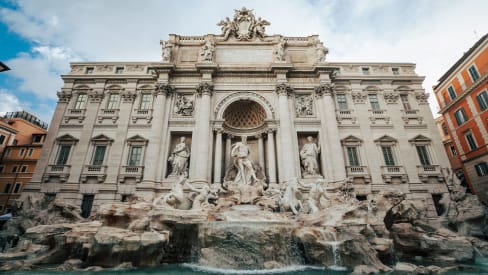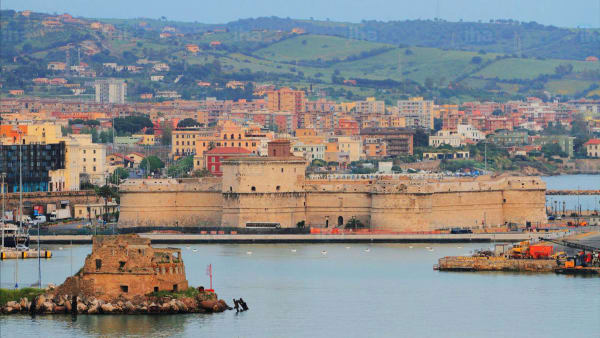Curiosities
Curiosities
Every day, about 80 million liters of water flow through the Trevi Fountain, thousands of tourists come to admire the masterpiece and over €4000 worth of coins are thrown into the basin. Keep reading to discover more interesting facts about the fountain!
The origin of its name
There are several theories about the origin of the name of the most famous fountain in the Eternal City.
The first hypothesis is that the name “Trevi” is a derivation of “Trebium,” the name of a village east of Rome where the spring from which the water originally came is located.
The second hypothesis is that the name is derived from “trivio”, the intersection of the three streets Collatina, Prenestina, and Tiburtina, from where the water originated.
The third hypothesis refers to Luturna, the nymph who was invoked during droughts and who had a temple named “Trevi”.
The dedication of Nicola Salvi
As mentioned in the historical section, in 1731 Clement XII announced a design competition that was eventually won by Nicola Salvi. With his intelligence and sensitivity, he pursued a humanistic education before studying architecture under the guidance of Antonio Canevari.
We can say without a doubt that the Trevi Fountain was the architect’s masterpiece, to which he devoted himself until his death and with which he concluded his career. Although he didn’t live to see the completion of the work, his affection for the monument led him to his death. It appears that he began to show the first signs of physical collapse through the numerous inspections of the tunnels of the Trevi Fountain aqueduct.
At one point half of his body was paralyzed, but he continued to find ways to oversee the construction of the work. For 30 years he prioritized this project and because of his dedication, his level of excellence is still compared to great Italian architects.
Through his attention to detail, perfectionism, and passion for literature, the artist was able to give the work different interpretations and possible meanings, to draw the viewer into a unique and evocative maritime world.
The traditional coin toss
Legend has it that if you stand with your back to the Trevi Fountain (with your eyes closed) and throw a coin into the water with your right hand over your left shoulder, you’ll be sure to return to Rome one day.
It’s also said that if you throw two coins, you’re sure to find love (some say with an Italian), while with three coins you’re guaranteed to marry.
This custom has now become a tradition among tourists. As a result, more than a million euros worth of coins is collected at the Trevi Fountain every year, which have been donated to charities since 2007.
The fountain of lovers
Another romantic legend related to love refers to the use of the Fontanina degli Innamorati (a small fountain of lovers). It can be found on the right side of the Trevi Fountain and was also designed by Nicola Salvi. Its function was to allow passersby to quench their thirst on hot days.
The two jets of water coming from this small fountain cross each other before entering the basin. This metaphor for the indissoluble bond between lovers would thereby give drinkers of the fountain everlasting love.
Especially among young soldiers, it was common to drink from the fountain together with their sweetheart before leaving. The girl would then bring a cup that was broken after drinking from it to seal the young man’s loyalty to his beloved and the capital.
The legend of the ace of cups and the barber
If you look at the right side of the fountain, you’ll see a round ornamental vase, commonly known as the ace of cups (because it resembles Italian playing cards). In terms of position, the vase doesn’t seem to add anything to the other decorations of the fountain.
According to legend, during the construction of the fountain, Nicola Salvi constantly received tiresome complaints and criticism from the barber who had a business overlooking the Trevi Fountain. Salvi decided to take revenge ironically and obstruct the barber’s view.
Eventually, the ace of cups was placed on the east side of the fountain. Today, if you stand behind the vase, you’ll discover that you can’t see anything of the fountain at all.
The secret balcony
Normally you can admire the Trevi Fountain only from the square. Yet, it’s possible to view the fountain from another angle, from the palace where the work is built against.
Thanks to a new museum tour of Palazzo Poli, you can admire the Trevi Fountain from the balcony. Here you can still see even the highest point of the work, the two angels playing tuba, just fine. Moreover, during your visit to the rooms of the palace, it’ll be possible to hear the sound of the water flowing to the fountain.
The fountain as a film set
The Trevi Fountain has an important role in representative scenes of twentieth-century cinema. The fountain has been the scenery for the films Roman Holiday, Three Coins in the Fountain, When in Rome, Angels & Demons, The Man from U.N.C.L.E., and La Dolce Vita.
In the last example, a film by the director Federico Fellini, the scene in which Anita Ekberg plunges into the fountain and addresses Marcello Mastroianni (the protagonist) with the words “Marcello vieni qui, sbrigati” (Marcello, come here. Hurry up!) has become world-famous.
Inscriptions
Given the countless decorations of the Trevi Fountain, some important elements of the work such as the inscriptions may go unnoticed.
Pope Clement XII wanted to add in the center of the two central statues the text “CLEMENS XII PONT MAX, AQVAM VIRGINEM, COPIA ET SALVBRITATE COMMENDATAM, CVLTV MAGNIFICO ORNAVIT, ANNO DOMINI MDCCXXXV PONTIF VI”. Translated from Latin, it means “Clement XII, Pontifex Maximus, embellished with splendid refinement the Acqua Virgo, esteemed for its abundance and wholesomeness, in the year of the Lord 1735, the sixth of his pontificate”.
The inscription just below it reads “PERFECIT BENEDICTUS XIV PONT. MAX” (Benedict XIV, Pontifex Maximus, made it perfect).
Finally, the inscription behind the statues of Abundance, Health, and Oceanus reads “POSITIS SIGNIS ET ANAGLIPHIS TABULIS IUSSU CLEMENTIS XIII PONT. MAX. OPUS CUM OMNI CULTU ABSOLUTUM A. D. MDCCLXII”. The translation says that the statues and reliefs were placed here on the orders of Clemens XIII Pontifex Maximus and that the work was completed without further work in the Year of our Lord 1762.
Famous protests and statements
The fountain has been the scene of protest performances by various artists and citizens. These are a few examples that have made (international) headlines.
Graziano Cecchini
The Italian artist and activist Graziano Cecchini, for example, decided to pour paint into the fountain in October 2017. He said the action was an act of protest to draw attention to government corruption in the Italian capital. Shortly after he turned the water a deep red color, the artist was arrested and escorted away from the scene by police.
In October 2007, the artist had pulled the same stunt earlier with the help of other activists. At that time, the police found pamphlets from “FTM Futurist Action 2007” at the fountain in which the following statement was made: “The unfortunate, the elderly, the sick, students and workers, we come with the red color to color your grayness”.
In 2008, the artist made the headlines again by dropping thousands of colored rubber balls down the Spanish Steps, another world-famous Roman landmark.
Adrián Pino Olivera
Spanish artist Adrián Pino Olivera, better known as the “art stripper” regularly goes nude near iconic works of art. Olivera’s actions are part of “Project V,” an art project in which he wants to use his naked body to “claim the divine power of the feminine and pass it on amidst the decline of the contemporary masculine world”.
In 2014, he pulled this stunt for the first time in front of Sandro Botticelli’s painting “The Birth of Venus” at the Uffizi Gallery in Florence. He later repeated this statement at the Nikè of Samothrace at the Louvre in Paris, “The Origin of the Milky Way” by Jacopo Tintoretto at the National Gallery in London, and the Trevi Fountain in Rome, among others.
Roberto Cercelletta (D’Artagnan)
In 2002, one of the most violent protests at the Trevi Fountain took place. The unemployed Roberto Cercelletta, better known to Romans as “D’Artagnan” or “the coin fisher” clearly disagreed with the ban on taking money from the fountain. Despite being arrested several times for this and receiving many warnings, he continued to do so.
In protest, he climbed on one of the winged horses of the work, wounded himself with a knife, and cursed the mayor for interrupting “his way of making a living”. After all, he had been diving into the fountain regularly for 34 years and was certainly not the only one doing so.
Today, the coins are taken out of the fountain every day (rather than once a week), cleaned, and donated to charities.
Angry brides at a flashmob
At a more recent protest in the form of a flashmob in July 2020, about 10 brides-to-be gathered at the fountain, all dressed in their wedding gowns with matching white parasols and masks. They were protesting against the strict COVID-19 restrictions that have been introduced for wedding ceremonies.
They also held signs with texts such as “I had already bought my wedding dress, but had to postpone the ceremony”, “The church is keeping its doors closed for marriage” and “Give us back the freedom to party.”
The flash mob was organized by the Italian association Airb, which organizes wedding ceremonies. The purpose of the protest was to ask the government for support to prevent the collapse of the sector that organizes wedding ceremonies and parties. But also to scrap restrictions such as the prohibition for the father of the bride to accompany her to the altar.















